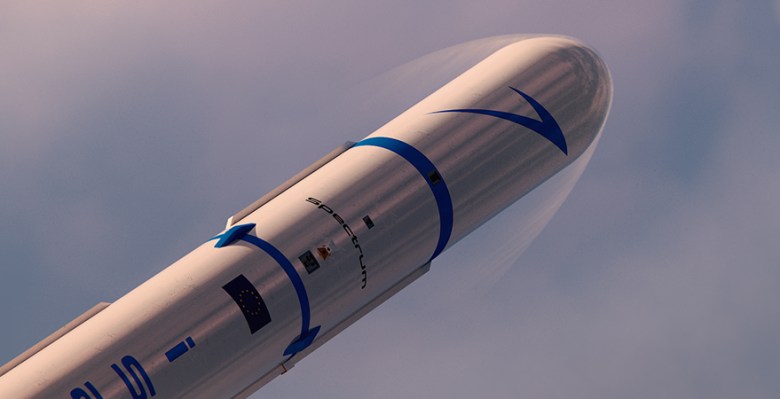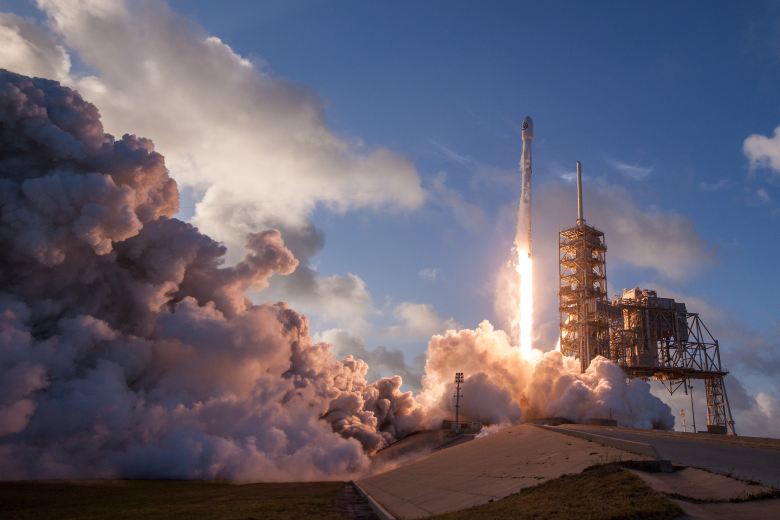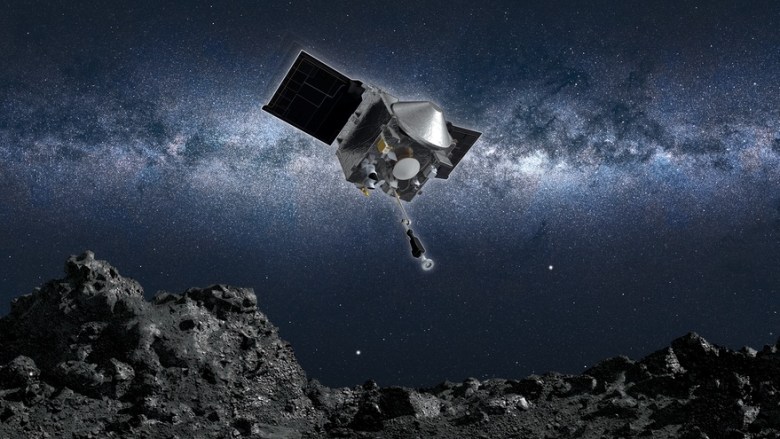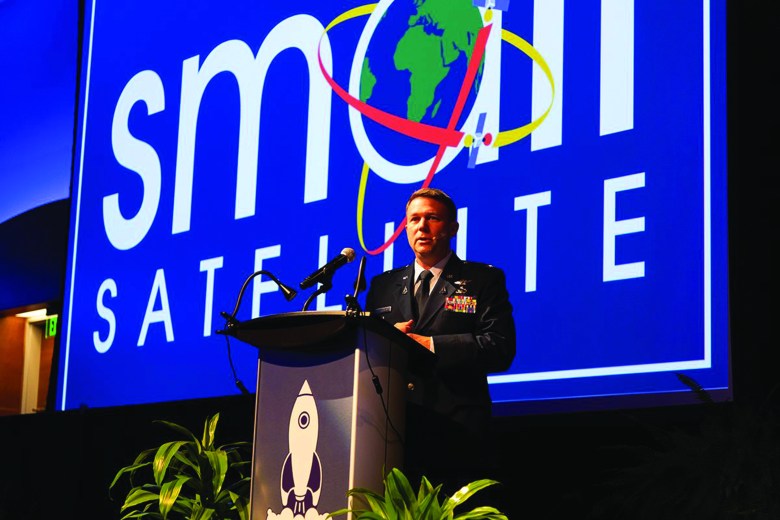SpaceNews established the awards in 2017 to recognize and celebrate the people, programs and institutions shaping a rapidly evolving global space economy. Chosen by SpaceNews journalists with invaluable input from previous winners of these awards, the 2023 class of SpaceNews Icons include a mix of heavyweight champions, scrappy newcomers and long-serving stalwarts of an industry it has been a privilege to cover since our 1989 debut amid the dawn of the commercial space era.
STARTUP OF THE YEAR: Isar Aerospace

Europe is in the midst of what officials there openly call a “launcher crisis.” A combination of development problems, launch failures and geopolitical complications have temporarily deprived Europe of the ability to launch its own satellites. The Ariane 6, once planned to enter service in 2020, has been pushed back to 2024, after the retirement of the Ariane 5. The Vega C small launch vehicle has been grounded since a December 2022 launch failure and won’t return to service until late 2024. Russia’s invasion of Ukraine last year deprived Europe of access to the Soyuz rocket, which had backstopped both Ariane and Vega.
Amid the current problems, though, are signs of hope for the future. Several startups across the continent are working on small launch vehicles, developed with only modest government support. Those vehicles, expected to begin launches in 2024, will offer Europe both new ways to get to orbit and new solutions for its launcher crisis.
One of the companies at the vanguard of that effort is Isar Aerospace. Named for the river that flows through its home city of Munich, the company is nearing the first launch of its Spectrum rocket, designed to place up to one ton of payload into orbit. The company has been performing acceptance testing of engines for the rocket and, in November, inaugurated a launch pad for the rocket at Norway’s Andøya Spaceport.
More impressive, perhaps, has been its ability to raise money. In March, Isar announced it raised $165 million in a Series C round from a group of European investors to help complete development and scale up production of Spectrum. The funding was one of the largest rounds raised by a space company in 2023 worldwide, and brings the total raised by Isar to date to $330 million — the most by a European space startup.
Remarkably, Isar raised the money even as other launch companies faced serious financial problems. Just a week after Isar closed its round, Virgin Orbit filed for bankruptcy, its assets later liquidated. Astra, which raised hundreds of millions going public through a SPAC merger in 2021, is now running low on cash and has delayed work on its new launch vehicle.
Isar has its own challenges as well. When it raised the Series C round, it expected to conduct its first Spectrum launch by the end of the year, but that has since slipped to sometime in 2024. It is also facing European competition from companies like
HyImpulse, Rocket Factory Augsburg, and Skyrora, all planning first launches in the coming year.
The progress Isar Aerospace and others have made has helped reshape the European launch landscape. At the European Space Summit in November, ESA member states agreed to a
package of financial support for Ariane 6 and Vega C, including a guaranteed number of institutional launches of each vehicle. However, they also agreed for the first time to open up some government missions to competition from other launch companies. That was only possible because of the progress, both technical and financial, that Isar Aerospace and others have made in providing new ways for Europe to reach space and helping get it out of its current launcher crisis.
DEAL OF THE YEAR: Eutelsat-OneWeb Merger

Eutelsat and OneWeb’s merger has created the only global operator with wholly owned satellites in low Earth orbit (LEO) and the geostationary arc, promising hybrid capabilities they believe will give them the edge on fierce competition in the broadband market.
The all-share deal combining French operator Eutelsat’s 36 satellites in geostationary orbit (GEO) with U.K.-based OneWeb’s LEO constellation of more than 600 spacecraft also came at a critical juncture for both companies.
Eutelsat was looking for ways to turbocharge a pivot into high-growth connectivity services as its legacy satellite TV business dwindled. At the same time, OneWeb sought a boost to take on the growing dominance of SpaceX’s Starlink LEO network.
OneWeb had suffered multiple setbacks and only recently deployed enough satellites to enable global services before the end of this year. Launches using Russian Soyuz rockets were first put on hold after the pandemic pushed the company into bankruptcy in 2020. The British government and an Indian conglomerate rescued OneWeb from Chapter 11, only for Soyuz to be caught up in sanctions against Russia following its February 2022 invasion of Ukraine.
SpaceX’s Falcon 9 came to the rescue this time, along with GSLV Mark 3 rockets from India that enabled OneWeb to resume launches seven months later.
But in the meantime, OneWeb was forced to watch from the sidelines as Starlink made gains in important enterprise markets, including aviation and maritime customers that many satellite operators are banking on for growth — including Eutelsat.
Eutelsat’s established distribution channels around the world should help accelerate the commercialization of OneWeb satellites now in LEO, where broadband can be provided with lower latency compared with orbits much
farther from Earth.
Low latency is important for many applications, from gaming to cloud-based networking. GEO satellites flying 35 times higher than LEO satellites, though, still have an advantage when it comes to delivering larger volumes of capacity to high-traffic areas, important for relieving congested networks at hotspots such as bustling airports.
The combined Eutelsat OneWeb group believes multi-orbit networks working in concert will be vital for meeting future connectivity needs as demand for bandwidth soars.
Other operators are also positioning their businesses for a multi-orbit future amid a shift toward hybrid networks
pioneered a decade ago by SES, Eutelsat’s European rival with satellites in GEO and medium Earth orbit (MEO).
Telesat, a Canadian GEO operator, has plans for a LEO constellation called Lightspeed that SpaceX is due to begin launching in 2026. Intelsat is supplementing its GEO network with services from OneWeb satellites as it plots a MEO constellation in 2027, and geostationary giant Viasat is considering non-geostationary options after acquiring Inmarsat in a $6.2 billion deal.
Key to Eutelsat OneWeb’s success in this evolving landscape is the shape of a second-generation LEO network the group plans to deploy in 2027 to take advantage of its GEO backbone.
Eutelsat has estimated OneWeb Gen 2 would cost $4 billion. That’s a heavy investment, but not one that deterred the more than 87% of Eutelsat shareholders voting at its general meeting in September in favor of the OneWeb merger.
Now, Eutelsat OneWeb just needs to show a fully owned and integrated GEO-LEO constellation can deliver the strategic advantage its constituents have been looking for.
COMMERCIAL SPACE ACHIEVEMENT OF THE YEAR: SpaceX launch tempo

Most launch companies announce their next missions days, weeks, or even months in advance. By contrast, in late November, SpaceX publicly announced its next launch just three hours before a Falcon 9 lifted off from Cape Canaveral, carrying a payload of Starlink satellites.
That limited advance notice reflects the rapid pace of launch activity at the company: There’s little need to announce launches weeks in advance when SpaceX is launching two to three times a week. SpaceX announced plans early in 2023 to conduct 100 launches in the year, and as of the end of November, it had launched 83 Falcon 9 rockets, four Falcon Heavy rockets and two test flights of its Starship vehicle. By contrast, SpaceX launched 31 rockets, all Falcon 9
vehicles, in 2021.
The increased cadence is linked to SpaceX’s mastery of reusability. Nearly all the Falcon 9 missions this year involved reused boosters that have flown, in some cases, up to 18 times each. The company also regularly reuses payload fairings, meaning a typical launch might only require a new upper stage. Improvements in ground infrastructure allow the company to conduct launches from the same pad just four days apart.
That high flight rate is essential for both SpaceX and the overall space industry. More than half of SpaceX’s launches in 2023 have carried Starlink satellites as the company works to build out the constellation to serve a growing number of customers, as well as race Federal Communications Commission license milestones.
SpaceX’s rapid launch cadence comes as much of the rest of the launch industry struggled to get off the launch pad in 2023. A combination of development delays, launch failures, and geopolitics have sharply reduced the supply of vehicles not named Falcon. Customers unwilling to wait several years have little choice but to go to SpaceX, where they have found plenty of near-term launch opportunities.
That’s resulted in contracts that would have been considered unthinkable just a few years ago. Telesat announced in September it would launch its Lightspeed constellation, a competitor to Starlink, on Falcon 9 despite earlier having signed launch contracts with Blue Origin and Relativity Space. The European Space Agency launched its Euclid space telescope on a Falcon 9 in July, with two more missions to launch on that rocket in 2024. The European Commission said in November it was finalizing a contract for two Falcon 9 launches of Galileo navigation satellites in 2024.
SpaceX plans to continue increasing its launch rate. At a Senate hearing in October, Bill Gerstenmaier, SpaceX’s vice president for build and flight reliability, said the company was planning to perform 12 launches a month in 2024, or 144 for the full year.
Tom Ochinero, SpaceX’s vice president of commercial sales, suggested in March that the company could go to as many as 200 Falcon launches a year. “We have the hardware, we have the infrastructure, we can scale the staffing,” he said. “There isn’t any reason why we can’t keep going.”
CIVIL SPACE ACHIEVEMENT OF THE YEAR: OSIRIS-REx sample return

Sample return is at the apex of NASA’s planetary science exploration strategy in terms of both its benefits and complexity. Bringing material back from another world allows it to be studied with instruments far more sophisticated than what can be sent on a spacecraft. Samples can also be preserved for analysis by future generations of scientists with more advanced equipment, as is the case today with lunar material returned by the Apollo missions. However, designing a spacecraft to carry out such a mission can be extremely difficult and expensive, as shown by NASA’s current struggles with the Mars Sample Return program.
One NASA mission that demonstrated the benefits of sample return are worth the costs is OSIRIS-REx. On Sept. 24, a capsule landed in the Utah desert with about 250 grams of material from the near-Earth asteroid Bennu inside. The capsule’s contents were whisked to the same curation facility at the Johnson Space Center that holds the Apollo samples, where scientists immediately started analyzing them.
To say those scientists were excited by their first look at the material from Bennu would be an understatement. “We picked the right asteroid and, not only that, we brought back the right sample,” said Daniel Glavin, one scientist involved in the mission, at a briefing a couple weeks after the samples arrived. “This stuff is an astrobiologist’s dream.”
NASA selected the $1.16 billion mission — whose name is a convoluted acronym for Origins, Spectral Interpretation, Resource Identification and Security-Regolith Explorer — in 2011 as part of its New Frontiers line of planetary science missions. Scientists hoped that the samples would help them understand the formation of the solar system and the building blocks of life on Earth.
That initial analysis of the samples, showing them rich in carbon and hydrated minerals, appears to confirm those hopes. “We’re already thrilled with the results,” said Dante Lauretta, principal investigator for OSIRIS-REx at the University of Arizona.
OSIRIS-REx was not without its difficulties. When the spacecraft arrived at Bennu in 2018, scientists discovered the asteroid’s surface was strewn with rocks, making it more difficult to find a spot to safely collect samples in a “touch-and-go” maneuver. When the spacecraft carried out that maneuver in October 2020, it found the surface was very porous — like a ball pit, scientists later said — and the spacecraft’s sample arm plunged deeper into the surface than planned before pulling away, its sample head overflowing with material. The capsule was so full of material that, back on Earth, scientists have struggled to get it open: a literal embarrassment of riches.
The main OSIRIS-REx spacecraft, after releasing the sample canister in September, flew by Earth on a new extended mission called OSIRIS-APEX that will take it to another near-Earth asteroid, Apophis, in 2029. Long after that extended mission is over, scientists will likely still be examining the material OSIRIS-REx bought back from Bennu, proof that the value of sample return is worth the expense of getting those materials back to Earth.
SPACE STEWARDSHIP: T.S. Kelso

If the skies were cloudy when NASA’s Skylab space station passed over Kansas City shortly before reentering Earth’s atmosphere in July 1979, the world might never have gained one of its most dedicated space safety and sustainability experts.
Watching Skylab pass overhead inspired T.S. Kelso to put his recently acquired desktop computer to use tracking artificial satellites. Forty-four years later, Kelso continues to keep tabs on satellites and orbital debris through CelesTrak, a free web-based service he established in 1985 to share orbital locations and analytical tools.
Kelso’s accomplishments would fill many articles. But here are some of the highlights.
He earned a Ph.D. in mechanical engineering operations research from the University of Texas, Austin, and completed 31 years of active-duty military service, retiring as a colonel. During a 17-year career at AGI and Comspoc, Kelso provided expertise to the company’s research arm, the Center for Space Standards and Innovation.
While leading the U.S. Air Force Space Command’s Space Analysis Center in the early 2000s, Kelso became acutely aware of the U.S. military’s overwhelming reliance on commercial communications satellites and the fact that the Defense Department was not screening them for potential collisions in geostationary orbit.
After retiring from the Air Force, he developed online tools to identify conjunctions and helped establish the Space Data Association, an international organization that enables satellite operators to share ephemeris data and maneuver plans securely, as well as the Space Data Center, which assesses collision risks and issues warnings.
During his lengthy career, Kelso taught extensively. At the Air Force Institute of Technology at Wright Patterson Air Force Base in Ohio, he served as an assistant professor of space operations and associate dean of the Graduate School of Engineering.
While in the Air Force, Kelso led the Department of Defense’s analysis of the 2003 Space Shuttle Columbia accident, which provided evidence that helped explain why Columbia broke apart on reentry, killing the seven astronauts onboard.
Earlier in his career, Kelso established training for Air Force personnel assigned to the Consolidated Space Operations Center near Colorado Springs when it took over military satellite and Space Shuttle programs previously managed by government contractors at the Satellite Test Center in Sunnyvale, California. He also supervised the team of Air Force and contractor personnel managing operations of nine Block 1 Global Positioning System satellites.
An Air Force Academy graduate, Kelso earned a master’s in space operations from the Air Force Institute of Technology and a master’s in business administration focused on quantitative methods from the University of Missouri, Columbia.
In addition to being a fellow of the American Astronautical Society and an associate fellow of the American Institute of Aeronautics and Astronautics, Kelso was the inaugural recipient (and remains the namesake) for the Space Data Association’s T.S. Kelso Award for Space Safety.
USUNG HERO: Utah State University’s Small Satellite Conference

Thousands of people travel to Logan, Utah, every August for the annual Small Satellite Conference at Utah State University.
Unlike other conferences where people frequently dash off to visit colleagues or customers, SmallSat participants tend to linger, remaining on campus throughout the day for technical sessions and side meetings, meals, coffee, and snacks.
“We do a lot of things here to promote interaction,” said Pat Patterson, Utah State Space Dynamics Laboratory advanced concepts director and SmallSat conference chair.
SmallSat dates back to 1987, when a few dozen university research professors were looking for affordable ways to augment classroom instruction for aerospace engineering students. At the time, that meant pooling resources to build miniature satellites.
“You bring the sensor, I’ll bring the power system, and maybe we can afford to build it,” Patterson said. “The whole point was getting these folks to collaborate.”
Nearly 38 years later, SmallSat remains true to its academic roots and spirit of collaboration. Researchers showcase their work through poster sessions. And the SmallSat Student Competition awards college scholarships for innovative satellite concepts, research and missions.
While the SmallSat Conference ballooned to 3,700 participating in 2023, attendees continue to share buffet lunches at long tables under a tent on the grassy quad.
“Lots of times where you’ll have a colonel sitting next to professor and across from a student and somebody from Lockheed Martin,” said Patterson, who attended the first SmallSat as a Utah State student in 1987, joined the SmallSat Committee in 1997 and has been overseeing the conference since 2000.
SmallSat also promotes interaction through jam-packed exhibit halls where attendees line up for Aggie ice cream, an afternoon treat produced on campus with milk from Utah State’s Caine Dairy.
Unlike other conferences where prime contractors can opt for expansive booths with meeting rooms and seating areas, SmallSat offers only single or double booths.
“That is intentional because we want the entire community to be here,” Patterson said. “We want companies with three people to have just as much opportunity to showcase their wares on the floor as the big boys.”
In spite of spearheading the event, which is expected to bring 4,000 people to Logan in 2024, Patterson deflects credit for its success to SmallSat committee members, staff and volunteers, who evaluate hundreds of single-page proposals for technical sessions, short talks called Swifties and poster sessions.
For SmallSat attendees, who wonder how long the expanding event can remain in Logan given the dearth of hotel rooms, Patterson has a message.
“If it moved to a big city, it would lose the character and the cost would skyrocket,” Patterson said. “We’ve looked into a bigger venue several times. Everything just goes berserk when it comes to cost.”
MILITARY SPACE ORGANIZATION OF THE YEAR: Space Systems Command’s Commercial Space Office (COMSO)

As innovation in space technology rapidly accelerates globally, the U.S. Space Force finds itself at an inflection point. Mission success relies not just on building traditional military hardware but on leveraging advancements from the burgeoning commercial space industry.
Efforts to bring cutting-edge commercial space capabilities into the national security realm are being spearheaded by the Space Systems Command’s Commercial Space Office (COMSO).
COMSO is being recognized for its work facilitating the adoption of new commercial space technologies across the Space Force. At a time when the space domain is growing more contested — and is becoming the latest front for U.S.-China strategic competition — COMSO leaders understand the importance of aligning entrepreneurial vigor with national defense priorities.
“In order to be successful, we really need to start migrating away from thinking that we have to build everything in-house,” says U.S. Space Force Col. Richard Kniseley, senior materiel leader at Space Systems Command and head of COMSO.
“We need to shift to a mindset to start getting sufficient capability out there fast to the warfighter,” Kniseley insists.
The Space Systems Command established COMSO in April 2023 as a “one-stop shop,” combining a patchwork of commercial endeavors into a more streamlined organization. “That enables us to understand and tap into the robust commercial marketplace,” says Kniseley. He explains that COMSO “openly engages industry to solve government challenges and opportunities.”
The Space Force needs to be “constantly evaluating where we can go with commercial industry, and to regularly meet with companies to understand their capabilities going forward,” Kniseley adds, noting that the mantra at Space Systems Command is to “build what we must and buy what we can.”
Some of the commercial activities under COMSO existed before the office was created, such as the Commercial Satellite Communications Office, the SpaceWERX organization and the Space Enterprise Consortium. SpaceWERX awards small business innovation research contracts and serves as a strategic financing hub to help startups attract investors. The SpEC consortium manages prototyping projects where established defense contractors team up with nontraditional firms.
Other elements of COMSO are newer initiatives, such as a web portal called “front door,” aimed at helping startups find contacts and sign up for meetings. COMSO also runs a space domain awareness marketplace that facilitates interaction and transactions between space data producers and consumers.
Its newest project is the commercial space reserve — a concept similar to the commercial reserve air fleet, where airlines agree to provide the government with airlift services during emergencies. The details of a commercial space reserve are still being worked out, and the Pentagon has expressed support for the program.
For all its early momentum, COMSO faces headwinds. Old procurement habits in the Pentagon die hard. And the preponderance of military space dollars still flows towards expensive, custom-built systems, not the commercial alternatives the office seeks to promote. Not everyone in the commercial space industry is convinced that COMSO can transform entrenched military procurement practices, as there are pockets of skeptics who instinctively distrust the reliability and security of commercial space services not purpose-built to strict military specifications.
However, COMSO is slowly exposing more Space Force members to cutting-edge commercial capabilities while educating private sector firms on specialized government needs.
An upstart in the military space-industrial complex, COMSO is postured to become a force for change in the defense procurement bureaucracy, step by step, contract by contract.
All 2023 HONOREES
The winners of the 2023 Icon Awards came from an impressive list of finalists. These companies, missions, organizations and individuals have accomplished major achievements in the last year and, in many cases, over many years. Below are brief summaries of these other honorees in the award categories.
Startups of the Year
IMPULSE SPACE Led by none other than SpaceX founding rocket designer Tom Mueller, Impulse Space is making waves in the industry by raising an impressive $75 million since last year. What sets them apart? Impulse Space is on a mission to build an in-space transportation company, positioning itself to take full advantage of Starship’s market-transforming rideshare capabilities. Their innovation has the potential to reshape the space transportation landscape..
KEPLER COMMUNICATIONS Hailing from Canada, Kepler Communications has attracted widespread attention with its $92 million Series C funding round this year. This investment is fueling their expansion from low data rate IoT connectivity into optical data relay, a hot market driven by the U.S. Space Development Agency’s keen interest in laser communications. Kepler Communications is playing a pivotal role in shaping the future of proliferated LEO communications and missile-tracking constellations.
THE EXPLORATION COMPANY Established in 2021, The Exploration Company has achieved an extraordinary milestone by raising $44 million this year, a record Series A for a European space startup. While this sum might be overshadowed by larger Series A funding rounds in the United States, it marks a significant accomplishment for the European venture capital market. The Exploration Company is focused on resupplying the burgeoning array of commercial space stations in development. The venture plans to launch its first reentry demonstrator next year, likely on a Falcon 9.
Deals of the Year
VIASAT’s INMARSAT ACQUISITION Viasat’s expansion beyond the North and South American broadband markets it has served from GEO for decades got a turbo boost from its acquisition of maritime-heavy Inmarsat and its fleet of 15 GEO satellites. Scale has its advantages in a consolidating market. The combined Viasat-Inmarsat, with 60% more revenue than Viasat alone, is better positioned to absorb the loss of ViaSat-3 Americas to a crippling deployment failure.
TELESAT’s LIGHTSPEED PARTNER PIVOT Telesat finally has funds for a LEO broadband network after pivoting from Thales Alenia Space to smaller but equally capable satellites from MDA. The Canadian operator booked SpaceX for 14 launches between mid-2026 and mid-2027 to fully deploy all 198 satellites Lightspeed needs to provide global coverage. While Telesat had hoped to start expanding out of GEO years earlier, the company expects the delays will be a blessing in disguise for a constellation now set to be $2 billion cheaper with MDA.
L3 HARRIS’s AEROJET ROCKETDYNE ACQUISITION The completion of L3Harris’ $4.7 billion deal this summer to acquire Aerojet Rocketdyne capped a period of uncertainty for the storied rocket engine manufacturer. Lockheed Martin in 2020 sought to buy it for $4.4 billion. That acquisition was blocked by the Federal Trade Commission. The combination strengthens L3Harris’ position in propulsion systems and the space market through expanded capabilities in technology for defense, civil and commercial applications. For Aerojet, being part of L3Harris provides greater financial scale and access to capital that can support and accelerate Aerojet’s R&D and product development efforts.
Commercial Space Achievements
INTELSAT AND SES MEET C-BAND DEADLINES Intelsat and SES are due a combined $7 billion windfall for returning publicly owned C-band to the FCC, on top of the $2 billion already received for helping make the spectrum available for U.S. telecom networks. The funding helps the companies as they navigate a shifting satellite communications market that will increasingly depend on non-geostationary satellite constellations. For Intelsat, that includes considering using its C-band windfall to develop a medium Earth orbit constellation.
VIRGIN GALACTIC’s FIRST COMMERCIAL SPACESHIPTWO FLIGHTS After years of development delays, including a fatal accident in a 2014 test flight, Virgin Galactic started commercial flights in June, and continued to fly about once a month into November. This allows the company to finally serve customers who, in some cases, bought tickets more than 15 years ago while working on a new generation of vehicles that promise more frequent and less expensive suborbital flights.
Civil Space Achievements
CHANDRAYAAN-3 LUNAR LANDING India joined a small club of nations to have successfully landed on the moon. So far this century, no one besides China — and now India — has completed a lunar landing, although plenty have tried (excluding, notably, the United States). Underscoring the difficulty of this feat, Chandrayaan-3’s Aug. 23 landing near the moon’s south pole followed on the heels of failed attempts by Japanese commercial venture ispace on April 25 and Russia on Aug. 19.
TROPICS More than a decade went into the development of the 12-channel passive microwave radiometer small enough to fit into a 3U cubesat form factor. The mission overcame the obstacle of losing the first two on an Astra rocket failure in 2022, with the remainder launching on two Rocket Lab Electrons in May and commissioned in time for the start of the 2023 hurricane season.
NASA’s PSYCHE LAUNCHES NASA’s Psyche mission to the metallic main-belt asteroid of the same name is back on track after software testing issues forced the mission to miss its original launch window in August 2022. Those problems prompted changes at the Jet Propulsion Laboratory, correcting institutional issues that could have imperiled other missions run by the lab.
ESA’s JUPITER ICY MOONS EXPLORER (JUICE) LAUNCHES The ESA-funded, Airbus-built JUICE mission launched in April on an eight-year voyage to Ganymede, Callisto and Europa, considered three of Jupiter’s most tantalizing moons because of the possibility of liquid oceans hidden beneath their icy surfaces.
Unsung Heroes
SPACE ISAC The Space ISAC was established in 2019 by aerospace, information technology and space companies to improve cybersecurity. The nonprofit facilitates collaboration among companies and government agencies in identifying and responding to physical and cyber threats to spacecraft and terrestrial infrastructure. At the Space ISAC Operational Watch Center in Colorado Springs, analysts monitor space-related data to detect anomalies.
JEFFREY MANBER, NANORACKS Manber has been a pioneer in commercial space activities since his work with Russian space companies in the 1990s as they navigated the transition from Soviet-era control. He later founded Nanoracks, which became one of the first companies to make commercial use of the ISS, from launching cubesats to developing the Bishop airlock. The company is now at the forefront of efforts to develop commercial space stations to succeed the ISS. Manber received NASA’s 2023 Distinguished Public Service Medal.
MARCIA SMITH, SPACEPOLICYONLINE.COM With more than four decades of experience in space policy, Smith is an indispensable resource of clear and concise news, information and analysis about U.S. civil, commercial and military space programs. Smith, a founding member and past president of Women in Aerospace, spent 31 years working at the Congressional Research Service and three at the National Academies’ Space Studies and Aeronautics and Space Engineering Boards. A fellow of the American Institute of Aeronautics and Astronautics and a fellow of the American Astronautical Society, Smith is the founder and editor of SpacePolicyOnline and editor of the quarterly journal, Space Policy.
Space Stewardship
MORIBA JAH An astrodynamicist with a Ph.D. in aerospace engineering, Jah is well known for promoting space environmentalism in both industry and academia. As a professor at the University of Texas at Austin, he and colleagues developed tools to merge datasets of space objects from academia, industry and government. The resulting catalogs plus visualization tools are available through free online platforms, ASTRIAGraph and Wayfinder. Jah is also co-founder and chief scientist of Privateer Space, a company working on space traffic management technologies. Jah received a MacArthur Foundation “Genius Award” in 2022.
CONFERS The Consortium for Execution of Rendezvous and Servicing Operations (CONFERS) was established with the support of DARPA to create an industry forum for discussing standards and best practices for the emerging satellite servicing field. In the last year, CONFERS has become an organization independent of DARPA as it continues its work to further technology, policy and communications issues about satellite servicing.practices for the emerging satellite servicing field. In the last year, CONFERS has become an organization independent of DARPA as it continues its work to further technology, policy and communications issues about satellite servicing.
- SEO Powered Content & PR Distribution. Get Amplified Today.
- PlatoData.Network Vertical Generative Ai. Empower Yourself. Access Here.
- PlatoAiStream. Web3 Intelligence. Knowledge Amplified. Access Here.
- PlatoESG. Carbon, CleanTech, Energy, Environment, Solar, Waste Management. Access Here.
- PlatoHealth. Biotech and Clinical Trials Intelligence. Access Here.
- Source: https://spacenews.com/the-2023-spacenews-icon-awards-winners/



